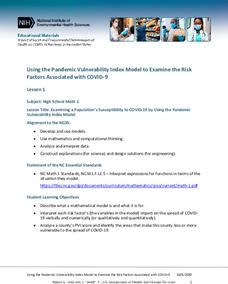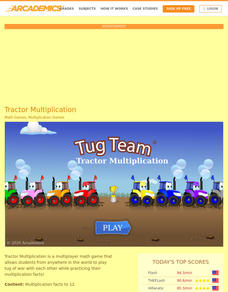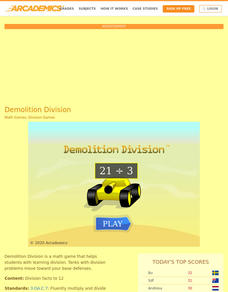Bowland
Counting Trees
Let's find a way to determine how many there are. Given a diagram of trees on a plantation, pupils devise a way to estimate the number of old and new trees. Using their methods, learners create estimates for the number of the two types...
Children’s Hospital of Philadelphia
Discovery and Development of Vaccines
Stop the spread. Pupils work through two activities to gain an understanding of vaccines and immunity. Learners research different types of vaccines and how they are made and explore the advantages and disadvantages of them. Using a...
Children’s Hospital of Philadelphia
Development of Disease and Infection
It's all in the cards. Using cards to simulate a disease's attack on the immune system, pupils develop an understanding of how the immune system and pathogens react to each other and why at times the pathogen wins. Groups play a game to...
Bowland
Lottery
Take a chance on raising money. Learners calculate probabilities to determine whether a lottery is a good way to raise money. Pupils determine the number of combinations of choosing two numbers between one and six. Using the sample...
Flipped Math
Calculus AB/BC - Estimating Limit Values from Tables
There's value in using a video to analyze a table of values. Pupils learn how to find the limit of a function from a table of values in the fourth of 18 lessons in Unit 1 - Limits and Continuity. An engaging video gives a tutorial on how...
Flipped Math
Calculus AB/BC - Can Change Occur at an Instant?
Be instantly transfixed by the idea of instantaneous rates of change. Scholars watch an informative video that introduces the fathers of calculus, Newton and Leibniz. They then learn about instantaneous rates of change by first...
National Institute of Environmental Health Sciences
Lesson 1: Using the Pandemic Vulnerability Index Model to Examine the Risk Factors Associated with COVID-19
How vulnerable are you to COVID-19? High school mathematicians use the Pandemic Vulnerability Index to create models that help them collect and analyze data about the risk factors associated with COVID-19. After investigating four groups...
Mathalicious
Pandemic
Young scientists use exponential growth and logarithms to model how a virus spreads through a population. Pupils watch a news clip about the 2012 outbreak of Ebola. Scholars then manipulate inactive graphs to see how various factors...
Museum of Science
Cookie Mining
Knock a chip off the cookie. Learners purchase a property to mine and mining tools. Pupils use their tools to mine chocolate chips out of a cookie for 5 minutes and return cookie fragments to its original site. After the time is over,...
Museum of Science
Make a Map
It's important to know the final destination. Scholars first measure distances in a region of interest using a standard measuring device or by counting steps. They then use an appropriate scale and graph paper to create a map of the...
Teach Engineering
Powering a Device Using Food
Eat up a resource on using food to power electrical devices. Future engineers first experiment with different fruits and vegetables to determine the amount of electrical energy they provide. Based on the data, they design and create an...
Arcademics
Tractor Multiplication
Use multiplication to help win a game of tug-of-war. An online game helps learners reinforce their multiplication facts. Selecting the correct answers to multiplication problems helps move a tractor in a tractor tug-of-war in their favor.
Las Cumbres Observatory
How Big is the Solar System?
Find out if it's possible to travel to the edge of the solar system. Learners use a piece of string to model the distance between planets in the solar system. They then use the distances to calculate how long it would take to travel to...
Las Cumbres Observatory
Plotting an Asteroid Light Curve
Data can tell us a lot about celestial objects that are just too far away to study otherwise. Learners examine data on the brightness of an asteroid to predict its rotation rate. Graphing the data reveals a periodic pattern that allows...
Las Cumbres Observatory
Plotting a Supernova Light curve
Supernovas burn for a short time but can give scientists extensive information about the universe. Learners analyze given data about the change in the light magnitude of a supernova. They look for patterns in the data and use them to...
California Academy of Science
Modeling Eclipses with Size and Distance Scales
Size within the solar system is a difficult thing for pupils to imagine. Using everyday objects, they build models to show the scale between the sun, moon, and Earth. They situate their props in proportional distances between the objects...
Arcademics
Penguin Jump
Don't jump to conclusions but to products instead. Pupils participate in an online race as penguins. Users choose the ice sheet with the correct product to the individual's multiplication prompt. The penguins jump from one product to...
Arcademics
Swimming Otters
Otters swim through numerical gates carrying multiplication equations with a missing factor. By choosing the gate with the correct missing factor, players make the otter swim faster in the online game.
Arcademics
Demolition Division
Divide and conquer! Learners fire quotients at tanks carrying division problems. Correct answers destroy the tanks as they approach the base defenses. Pupils play six rounds that are one minute each to finish the online game.
Arcademics
Drag Race Division
Pupils speed through division as they participate in an online drag race. By answering division questions, individuals provide a boost to their cars. Learners that can answer quickly and accurately win the race.
Arcademics
Division Derby
Run for the quotient. Classmates practice division facts to 12 by racing against each other in an interactive online game. Horses run around a track and receive extra boosts of energy for each correct response.
Arcademics
Pony Division
Divided we pull. Pupils play an online game to practice division facts. With each correct response, the players' ponies pull just a little more in a tug of war.
Arcademics
Dolphin Dash
Dolphins swim for coins. Pupils play an online interactive game to become the first dolphin around the track. Players choose the appropriate value for a collection of coins to increase their speed. The game accommodates up to 12 racers...
Arcademics
Dolphin Feed
Gather money with porpoise. Individuals click on a combination of coins and bills to match the displayed amount of money. Each collection feeds a dolphin, and the player that gathers the most correct amounts wins the online game.

























